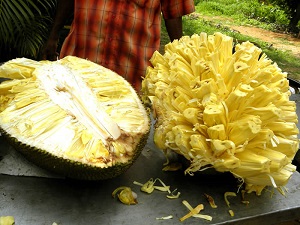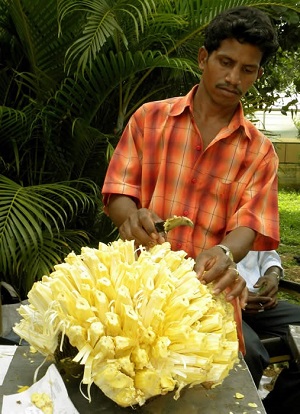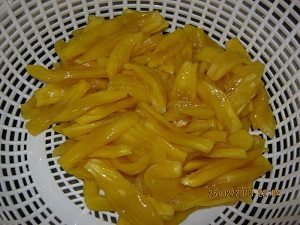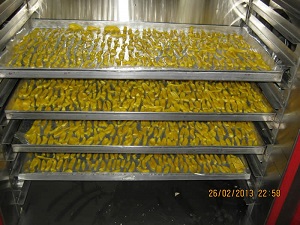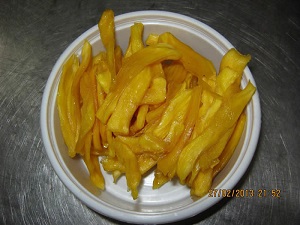Jackfruit Preparation From the Horticultural Sciences Department, Florida Cooperative Extension Service Institute of Food and Agricultural Sciences, University of Florida and by Shree Padre, from Jackfruit "The Wonder Fruit" blog 'Jack Flower' Unique way of opening Jackfruits
In India, the motherland of Jackfruit, there is diversity not only in jackfruit varieties, but in ways in which the ripe fruit is opened. See the photo. This farmer from Tumkur, Karnataka was selling lose fruit lets of their outstanding variety of Jackfruit in recently held Jackfruit workshop at University of Agricultural Sciences, Bangalore, India. 1 Dehydrated Ripe Jack Bulbs
In Florida Mature fruit have 35 to 40% edible flesh. However, it is not easy to determine when the fruit is ripe. There are several fruit characteristics that may be used alone or together indicate a particular cultivar is mature. In many cultivars the skin color changes from green to light green or yellow. Maturing fruits usually develop a strong aroma and the peel spines flatten and widen. Green fruits have a solid sound when tapped whereas ripe fruits have a hollow sound. 2 Harvest fruit with clippers or loppers. The cut stem will immediately exude white, sticky latex; this latex will permanently stain clothing. Wrap the cut end with a paper towel to make handling easier, or set the fruit on its side until the flow of latex ceases. Care should be exercised not to let the fruit drop to the ground and be damaged. You may want to wear gloves when handling the fruit. Place fruit in the shade until the latex stops exuding from the cut stem. 2 Mature fruit will ripen in 3 to 10 days at 75°F to 80°F (24-27°C). Before consumption the edible flesh is separated from the rag. As with harvesting, latex may exude from cut surfaces when extracting the flesh. To make clean-up easier coat hands, knife blades (not the handle), and work surfaces with vegetable oil. To clean the fruit, cut in half and remove the central core; then proceed to separate the flesh, seed, and rag. 2 Cool temperatures (60°F; 16°C) may delay ripening. The proper storage temperatures for jackfruit have not been determined. Fruit pulp may be stored in the refrigerator and fully ripe fruit segments may be placed in polyethylene bags and frozen for later use. 2 Further Reading How to Use Jackfruit, Fairchild Tropical Botanic Garden Virtual Herbarium Back to Jackfruit Page |
|||||
| Bibliography 1 Padre, Shree. "'Jack Flower' Unique way of opening Jackfruits." Farm science Centre of ICAR, Pathanamthitta District of Kerala, India, 8 July 2010, panasamwonders.blogspot.com. Accessed 20 Dec. 2014. 2 Crane, Jonathan H., et al. "Jackfruit Growing in the Florida Home Landscape." Horticultural Sciences Dept., UF/IFAS Extension, HS-882, Pub. date May 2002, Revised Oct. 2005 and Nov. 2016, Reviewed Dec. 2019, AskIFAS, edis.ifas.ufl.edu/mg170. Accessed 17 Jan. 2017, 6 July 2020. Photographs Fig. 1,2 Padre, Shree. "'Jack Flower' Unique way of opening Jackfruits." Farm science Centre of ICAR, Pathanamthitta District of Kerala, India, panasamwonders.blogspot.com. Accessed 20 Dec. 2014. Fig. 3,4,5 "Dehydrated Ripe Jak Bulbs." Farm science Centre of ICAR, Pathanamthitta District of Kerala, India. 2010, 2013. panasamwonders.blogspot.com. Accessed. 20 Dec. 2014. Published 26 Feb. 2015 LR. Last update 8 Sept. 2020 LR |
|||||
